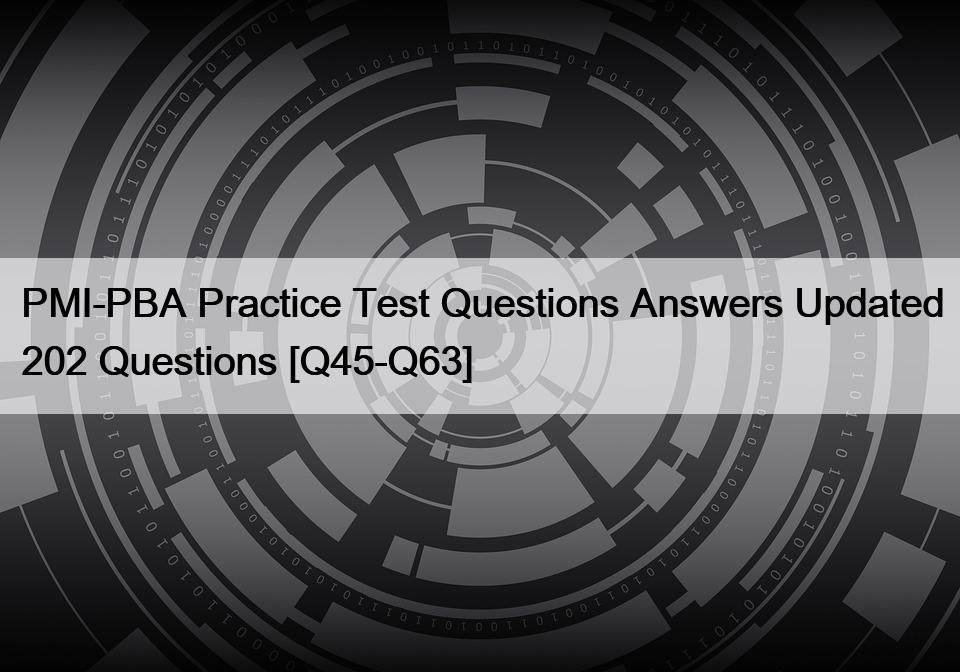
PMI-PBA Practice Test Questions Answers Updated 202 Questions
PMI-PBA dumps & PMI Professional in Business Analysis Sure Practice with 202 Questions
To pass the PMI-PBA test on the first try, the students should gain the necessary knowledge and skills, which will help them cover all the questions in the exam. All in all, the applicants will face with the following subject areas:
Needs Assessment: The first module evaluates the expertise of the examinees in collecting and analyzing the information from different sources utilizing valuation techniques and tools to determine the value of the initiative as well as providing the clarification of the business needs and solution scope to collaborate in the designing of project objectives and goals to adjust the product with the organization’s objectives and goals. Moreover, they need to have the competence in defining or reviewing the business problem for developing a solution scope statement or providing data to design a business case. In addition, the individuals should possess the experience in utilizing the elicitation techniques to determine stakeholder values concerning the product and give a baseline for prioritizing needs.
Planning: The next domain focuses on the proficiency of the learners in reviewing the business case, project objectives, and goals to present the context for the business analysis activities, utilizing the traceability techniques and tools to determine the strategies for requirements traceability, and define the level of traceability needed to validate & monitor the requirements as well as identifying roles, stakeholders, and communication protocols, responsibilities, and methods to develop the requirements management plan to elicit, analyze, document, manage, and approve requirements to establish a roadmap for performing the expected solutions. Besides that, it checks the skills in identifying channels for communicating processes and requests for managing changes to select methods for requirements change control and determine the standard protocols for incorporation into the change management plan.
Analysis: As for this part, the test takers need to show their competence in utilizing the individual and group elicitation techniques to identify the requirements for discovering and capturing the requirements with supporting details. Furthermore, they need to have the proficiency in analyzing, decomposing and elaborating the requirements utilizing various techniques, such as data and process modeling, interface analysis, and dependency analysis to clarify product capabilities & options. In addition, the examinees should possess the expertise in utilizing the valuation and decision-making techniques to estimate product capabilities & options, and determine the rejected, deferred, or accepted requirements as well as allocating deferred or accepted requirements to create a requirements baseline, and utilizing the decision-making techniques to get sign-off on requirements baseline, facilitate stakeholder agreement, and gain stakeholder approval.
Monitoring and Traceability: The next subject area evaluates the skills of the applicants in capturing the requirements’ relationships, sources, and status to give evidence that the requirements are fulfilled as stated, monitoring the requirements throughout their lifecycles to ensure the proper supporting requirements artifacts are reviewed, produced, and approved at every period in the lifecycle as well as updating a requirement’s status as it runs through its lifecycle phases by interacting with proper stakeholders and documenting changes in the traceability tool to track requirements towards the end. Moreover, it checks their competence in communicating the status of the requirements to the project manager and other stakeholders utilizing communication methods to keep them informed of requirements risks, conflicts, issues, changes, and overall status.
Evaluation: The last section checks the experience of the students in defining if the solution meets the requirements by validating the solution’s test evidence toward the requirements acceptance standards as well as analyzing and communicating the solution’s identified deltas and gaps utilizing the quality insurance methods & tools and to equip the stakeholders to determine differences between developed solution, requirements, and solution scope. Additionally, the applicants need to possess the proficiency in evaluating the expanded solution utilizing valuation techniques to define how the solution satisfies the value proposition and business case.
Eligibility Criteria
To get certified as a PMI-PBA, the applicant needs to meet one of the following sets of requirements that are based on educational level and professional experience:
- Bachelor’s Degree or global equivalent alongside 35 contact hours of business analysis practices and 36 months of working experience as a business analysis practitioner that must be gained within the last 8 years.
- High School Diploma/Associate’s degree or global equivalent along with 35 contact hours of business analysis practices and 60 months of working background as a practitioner of business analysis. The experience must be within the last 8 years.
- Bachelor’s or postgraduate degree from a Global Accreditation Centre (GAC) program or global equivalent supplemented with 35 contact hours of formal education as well as 24 months of unique non-overlapping professional business analysis experience.
PMI PMI-PBA Exam Syllabus Topics:
| Topic | Details |
|---|---|
| Topic 1 |
|
| Topic 2 |
|
| Topic 3 |
|
| Topic 4 |
|
New PMI-PBA Exam Questions| Real PMI-PBA Dumps: https://www.validexam.com/PMI-PBA-latest-dumps.html
Related Links: courses.learnwells.com learn.hedgex.in skillzonexpert.com academyworlds.com learnchillchill.com konturawellness.com






Leave a Reply